Synthesis and Characterization of Chromium Ion-Imprinted Biochar for Selective Removal of Cr(VI) from Wastewater
Abstract
1. Introduction
2. Method and Materials
2.1. Materials
2.2. Preparation of Straw Biochar
2.3. Preparation of Chromium Ion-Imprinted Materials
2.4. Material Characterization and Performance Testing
2.4.1. FT-IR
2.4.2. SEM
2.4.3. TGA
2.4.4. BET
2.5. Study on Chromium Adsorption for Cr(VI)-IIP-PEI@NBC
2.5.1. pH Value
2.5.2. Adsorption Duration and Kinetic Analysis
2.5.3. Initial Chromium Concentration and Adsorption Isotherm
2.5.4. Adsorption Temperature and Thermodynamics
2.6. Adsorption Property Selection and Reusability
3. Results and Discussion
3.1. Preparation of Biochar
3.2. Optimization of Cr(VI)-IIP-PEI@NBC Production Conditions
3.3. Optimization of Cr(VI)-IIP-PEI@NBC Adsorption Conditions
3.4. Material Characterization
3.4.1. SEM
3.4.2. FT-IR
3.4.3. TGA
3.4.4. BET
4. Conclusions
Author Contributions
Funding
Data Availability Statement
Conflicts of Interest
References
- Yu, J.; Yang, R. Study on the predictive algorithm of plant restoration under heavy metals. Sci. Program. 2021, 2021, 6193182. [Google Scholar] [CrossRef]
- Chen, Y.G.; He, X.L.S.; Huang, J.H.; Luo, R.; Chen, S.H. Impacts of heavy metals and medicinal crops on ecological systems, environmental pollution, cultivation, and production processes in China. Ecotoxicol. Environ. Saf. 2021, 219, 112336. [Google Scholar] [CrossRef]
- Liu, P.; Ptacek, J.C.; Blowes, W.D.; Finfrock, Y.Z.; Liu, Y. Characterization of chromium species and distribution during Cr(VI) removal by biochar using confocal micro-X-ray fluorescence redox mapping and X-ray absorption spectroscopy. Environ. Int. 2020, 134, 105216. [Google Scholar] [PubMed]
- Lisbania, V.; Mohammad, S.N.; Edwin, E.; Marta-Lena, A.; Farid, A. Adsorption of heavy metal ions by various low-cost adsorbents: A review. Int. J. Environ. Anal. Chem. 2020, 102, 342–379. [Google Scholar] [CrossRef]
- Gibb, H.; Lees, P.; Pinsky, P.; Rooney, B.C. Lung cancer among workers in chromium chemical production. Am. J. Ind. Med. 2000, 38, 115–126. [Google Scholar] [CrossRef]
- Yan, T.; Xu, Y.; Zhu, Y.; Jiang, P.; Zhang, Z.; Li, L.; Wu, Q. Chromium exposure altered metabolome and microbiome-associated with neurotoxicity in zebrafish. J. Appl. Toxicol. 2023, 43, 1026–1038. [Google Scholar] [CrossRef]
- Shan, R.; Shi, Y.; Gu, J.; Bi, J.; Chen, Y. Aqueous Cr(VI) removal by biochar derived from waste mangosteen shells: Role of pyrolysis and modification on its absorption process. J. Environ. Chem. Eng. 2020, 8, 103885. [Google Scholar] [CrossRef]
- Rajapaksha, A.U.; Alam, M.S.; Chen, N.; Alessi, D.S.; Ok, Y.S. Removal of hexavalent chromium in aqueous solutions using biochar: Chemical and spectroscopic investigations. Sci. Total Environ. 2018, 625, 1567–1573. [Google Scholar] [CrossRef]
- Jiang, X.; Liu, Y.; Yin, X. Efficient removal of chromium by a novel biochar-microalga complex: Mechanism and performance. Environ. Technol. Innov. 2023, 31, 103156. [Google Scholar] [CrossRef]
- Adviento-Borbe, M.A.; Arlene, A.; Linquist, B. Assessing fertilizer N placement on CH4 and N2O emissions in irrigated rice systems. Geoderma 2016, 266, 40–45. [Google Scholar] [CrossRef]
- Spokas, K.A. Review of the stability of biochar in soils: Predictability of O:C molar ratios. Carbon Manag. 2014, 1, 289–303. [Google Scholar] [CrossRef]
- Chen, S.; Han, J.; Zhu, Y.; Zhang, X.; Zheng, C.; Ma, L.; Liu, S.; Yang, Y.; Zou, L.; He, L. Preparation of biochar-based surface molecularly imprinted polymers and evaluation of their selective adsorption and removal of carbaryl from rice and corn. J. Chromatogr. A 2023, 2023, 464210. [Google Scholar] [CrossRef] [PubMed]
- Liu, S.; Cen, B.; Yu, Z.; Qiu, R.; Gao, T.; Long, X. The key role of biochar in amending acidic soil: Reducing soil acidity and improving soil acid buffering capacity. Biochar 2025, 7, 52. [Google Scholar] [CrossRef]
- Mukherjee, A.; Lal, R. The biochar dilemma. Soil Res. 2014, 52, 217. [Google Scholar] [CrossRef]
- Kurniawan, T.A.; Othman, M.H.D.; Liang, X.; Hui, H.G.; Gikas, P.; Chong, K.K.; Chew, K.W. Challenges and opportunities for biochar to promote circular economy and carbon neutrality. J. Environ. Manag. 2023, 332, 117429. [Google Scholar] [CrossRef] [PubMed]
- Biswas, B.; Balla, P.; Krishna, B.B.; Adhikari, S.; Bhaskar, T. Physiochemical characteristics of bio-char derived from pyrolysis of rice straw under different temperatures. Biomass Convers. Biorefinery 2022, 14, 12775–12783. [Google Scholar] [CrossRef]
- Xie, Y.; Wang, L.; Li, H.; Westholm, L.J.; Carvalho, L.; Thorin, E.; Yu, Z.; Yu, X.; Skreiberg, Ø. A critical review on production, modification and utilization of biochar. J. Anal. Appl. Pyrolysis 2022, 161, 105405. [Google Scholar] [CrossRef]
- Gholizadeh, M.; Meca, S.; Zhang, S.; Clarens, F.; Hu, X. Understanding the dependence of biochar properties on different types of biomass. Waste Manag. 2024, 182, 142–163. [Google Scholar] [CrossRef]
- Feng, Y.; Liu, P.; Wang, Y.; Finfrock, Y.Z.; Xie, X.; Su, C.; Liu, N.; Yang, Y.; Xu, Y. Distribution and speciation of iron in Fe-modified biochars and its application in removal of As(V), As(III), Cr(VI), and Hg(II): An X-ray absorption study. J. Hazard. Mater. 2020, 384, 121342. [Google Scholar] [CrossRef]
- He, R.; Yuan, X.; Huang, Z.; Wang, H.; Jiang, L.; Huang, J.; Tan, M.; Li, H. Activated biochar with iron-loading and its application in removing Cr(VI) from aqueous solution. Colloids Surf. A Physicochem. Eng. Asp. 2019, 579, 123642. [Google Scholar] [CrossRef]
- Li, Z.; Tian, W.; Chu, M.; Zou, M.; Zhao, J. Molecular imprinting functionalization of magnetic biochar to adsorb sulfamethoxazole: Mechanism, regeneration and targeted adsorption. Process Saf. Environ. Prot. 2023, 171, 238–249. [Google Scholar]
- Zhang, S.; Yang, X.; Le, L.; Ju, M.; Zheng, K. Adsorption Behavior of Selective Recognition Functionalized Biochar to Cd(II) in Wastewater. Materials 2018, 11, 299. [Google Scholar] [CrossRef]
- Wang, H.; Xin, W.; Cui, Y.; Xue, Z.; Ba, Y. Slow pyrolysis polygeneration of bamboo (Phyllostachys pubescens): Product yield prediction and biochar formation mechanism. Bioresour. Technol. 2018, 263, 444–449. [Google Scholar] [CrossRef]
- Shen, D.K.; Gu, S. The mechanism for thermal decomposition of cellulose and its main products. Bioresour. Technol. 2009, 100, 6496–6504. [Google Scholar] [CrossRef]
- Agegnehu, G.; Srivastava, A.K.; Bird, M.I. The role of biochar and biochar-compost in improving soil quality and crop performance: A review. Appl. Soil Ecol. 2017, 119, 156–170. [Google Scholar] [CrossRef]
- Inguanzo, M.; Menéndez, J.A.; Fuente, E.; Pis, J.J. Reactivity of pyrolyzed sewage sludge in air and CO2. J. Anal. Appl. Pyrolysis 2001, 58–59, 943–954. [Google Scholar] [CrossRef]
- Bojdi, M.K.; Mashhadizadeh, M.H.; Behbahani, M.; Farahani, A.; Davarani, S.S.H.; Bagheri, A. Synthesis, characterization and application of novel lead imprinted polymer nanoparticles as a high selective electrochemical sensor for ultra-trace determination of lead ions in complex matrixes. Electrochim. Acta 2014, 136, 59–65. [Google Scholar] [CrossRef]
- Kong, Z.; Du, Y.; Wei, J.; Zhang, H.; Fan, L. Synthesis of a new ion-imprinted polymer for selective Cr(VI) adsorption from aqueous solutions effectively and rapidly. J. Colloid Interface Sci. 2021, 588, 749–760. [Google Scholar] [CrossRef]
- Jia, J.; Wu, A.H.; Luan, S.J. Synthesis and investigation of the imprinting efficiency of ion imprinted nanoparticles for recognizing copper. Phys. Chem. Chem. Phys. 2014, 16, 16158–61615. [Google Scholar] [CrossRef] [PubMed]
- Wu, X.Y. Molecular imprinting for anion recognition in aqueous media. Microchim. Acta 2011, 176, 23–47. [Google Scholar] [CrossRef]
- Azizi, A.; Bottaro, C.S. A critical review of molecularly imprinted polymers for the analysis of organic pollutants in environmental water samples. J. Chromatogr. A 2020, 1614, 460603. [Google Scholar] [CrossRef]
- Tytlak, A.; Oleszczuk, P.; Dobrowolski, R. Sorption and desorption of Cr(VI) ions from water by biochars in different environmental conditions. Environ. Sci. Pollut. Res. 2015, 22, 5985–5994. [Google Scholar] [CrossRef]
- Chen, S.; Yue, Q.; Gao, B.; Qian, L.; Xing, X. Removal of Cr(VI) from aqueous solution using modified corn stalks, Characteristic, equilibrium, kinetic and thermodynamic study. Chem. Eng. J. 2011, 168, 909–917. [Google Scholar] [CrossRef]
- Bi, S.; Yang, X.; Zhang, B.; Tong, Y.; Zhang, F.; Tian, M. Preparation of polyethylenimine modified molecular imprinting adsorbent with immobilized metal oxides for highly efficient ovalbumin adsorption. Microchem. J. 2022, 180, 107583. [Google Scholar] [CrossRef]
- Nie, D.; Ma, R.; Zhang, Y.; Wang, W.; Nie, G.; Liu, G.; Liu, W.; Zou, D. Efficient removal of Cr(VI) from wastewater by composite adsorptive membrane modified with polyethyleneimine (PEI). Sep. Purif. Technol. 2024, 346, 127410. [Google Scholar] [CrossRef]
- Pattarith, K.; Nugroho, D.; Nanan, S.; Benchawattananon, R. Cellulose Modified with Polyethylenimine (PEI) Using Microwave Methodology for Adsorption of Chromium from Aqueous Solutions. Molecules 2023, 28, 4514. [Google Scholar] [CrossRef]
- Singh, S.; Arputharaj, E.; Dahms, H.U.; Patel, A.K.; Huang, Y.L. Chitosan-based nanocomposites for removal of Cr(VI) and synthetic food colorants from wastewater. Bioresour. Technol. 2022, 351, 127018. [Google Scholar] [CrossRef]
- Sun, H.; Wang, L.; Wang, X.; Dong, Y.; Xin, J.; Ren, J.; An, J.; Jing, R. Construction of recyclable magnetic PEI-modified GO/Fe3O4 adsorbents for high-efficient removal of Cr(VI) ions from aqueous solutions. Solid State Sci. 2024, 154, 107611. [Google Scholar] [CrossRef]
- Qu, J.; Bi, F.; Hu, Q.; Wu, P.; Ding, B.; Tao, Y.; Ma, S.; Qian, C.; Zhang, Y. A novel PEI-grafted N-doping magnetic hydrochar for enhanced scavenging of BPA and Cr(VI) from aqueous phase. Environ. Pollut. 2023, 321, 121142. [Google Scholar] [CrossRef]
- Li, M.; Guo, X.; Wei, Y.; Liu, A.; Liu, X. Adsorption mechanism and structure-performance relationship of chromium ions by biochar. Water Air Soil Pollut. 2020, 231, 517–523. [Google Scholar] [CrossRef]
- Zhou, Z.; Liu, P.; Wang, S.; Finfrock, Y.Z.; Ye, Z.; Feng, Y.; Li, X. Iron-modified biochar-based bilayer permeable reactive barrier for Cr(VI) removal. J. Hazard. Mater. 2022, 439, 129636. [Google Scholar] [CrossRef]
- Nakanishi, K.; Ding, L.; Guo, X.; Kanamori, K.; Yang, H. Functionalization of hierarchically porous silica monoliths with polyethyleneimine (PEI) for CO2 adsorption. Microporous Mesoporous Mater. 2017, 245, 51–57. [Google Scholar]
- Choi, K.; Lee, S.; Park, J.O.; Park, J.A.; Cho, S.H.; Lee, S.Y.; Lee, J.H.; Choi, J.W. Chromium removal from aqueous solution by a PEI-silica nanocomposite. Sci. Rep. 2018, 8, 1438. [Google Scholar] [CrossRef]
- Bai, K.; Fan, S.; Chen, Y.; Wang, Y.; Chen, J.; Mai, Z.; Liu, J.; Deng, L.; Xiao, Z. Membrane adsorber with hierarchically porous HKUST-1 immobilized in membrane pores by flowing synthesis. J. Membr. Sci. 2022, 650, 120424. [Google Scholar] [CrossRef]
- Wang, H.; Yuan, X.; Wu, Y.; Chen, X.; Leng, L.; Li, H.; Zeng, G. Facile synthesis of polypyrrole decorated reduced graphene oxide–Fe3O4 magnetic composites and its application for the Cr(VI) removal. Chem. Eng. J. 2015, 262, 597–606. [Google Scholar] [CrossRef]
- Guo, R.; Guo, W.; Pei, H.; Wang, B.; Guo, X.; Liu, N.; Mo, Z. Polypyrrole deposited electrospun PAN/PEI nanofiber membrane designed for high efficient adsorption of chromium ions (VI) in aqueous solution. Colloids Surf. A Physicochem. Eng. Asp. 2021, 627, 127183. [Google Scholar] [CrossRef]
- Bhaumik, M.; Maity, A.; Srinivasu, V.V.; Onyango, M.S. Removal of hexavalent chromium from aqueous solution using polypyrrole-polyaniline nanofibers. Chem. Eng. J. 2012, 181–182, 323–333. [Google Scholar] [CrossRef]
- Zhao, R.; Li, X.; Sun, B.; Li, Y.; Li, Y.; Yang, R.; Wang, C. Branched polyethyl enimine grafted electrospun polyacrylonitrile fiber membrane: A novel and effective adsorbent for Cr(VI) remediation in wastewater. J. Mater. Chem. A 2017, 5, 1133–1144. [Google Scholar] [CrossRef]
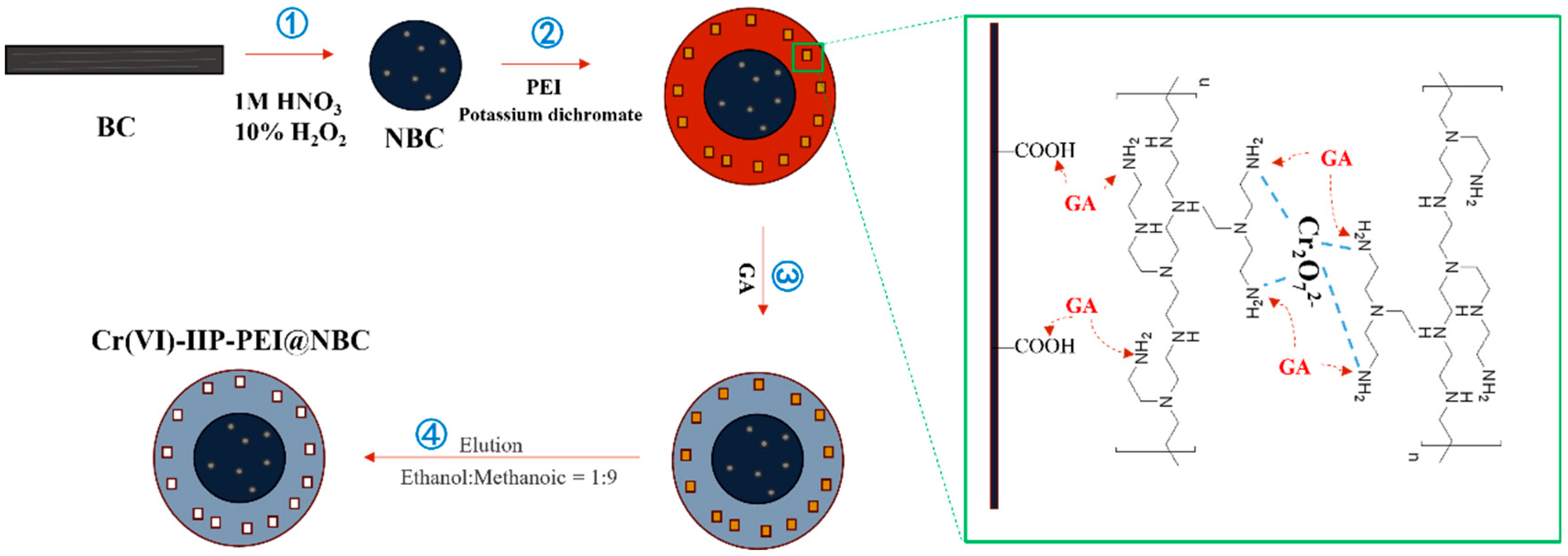
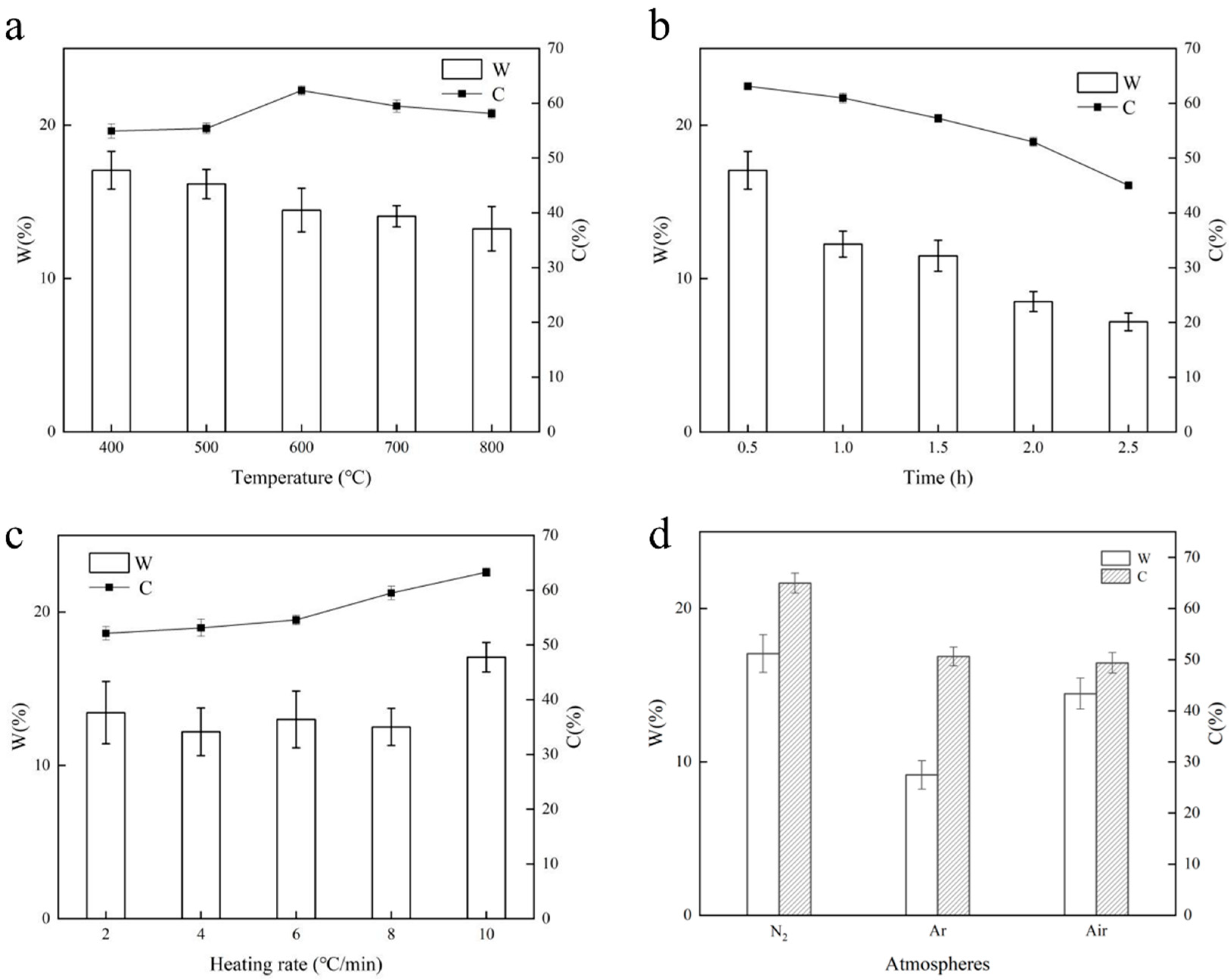
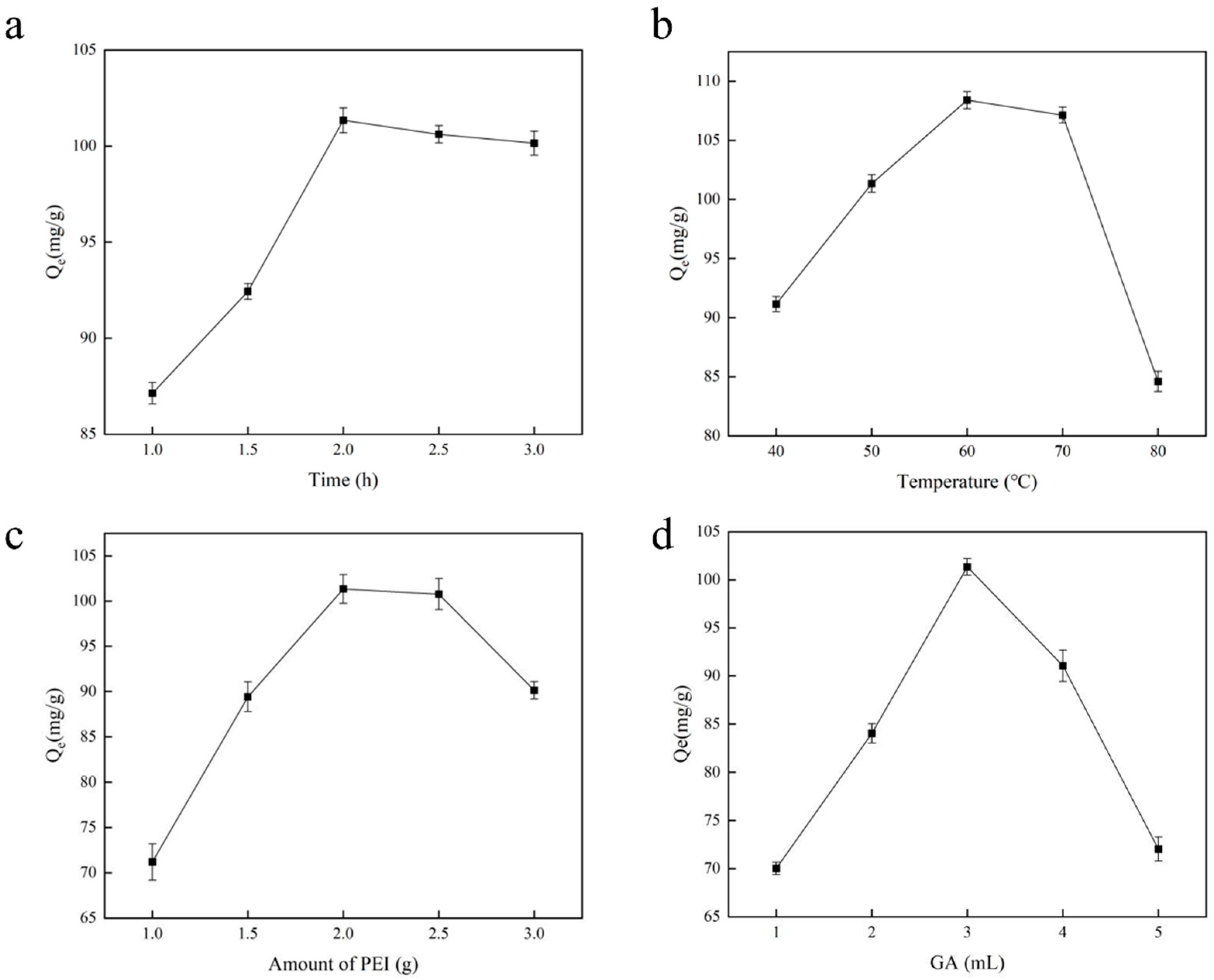
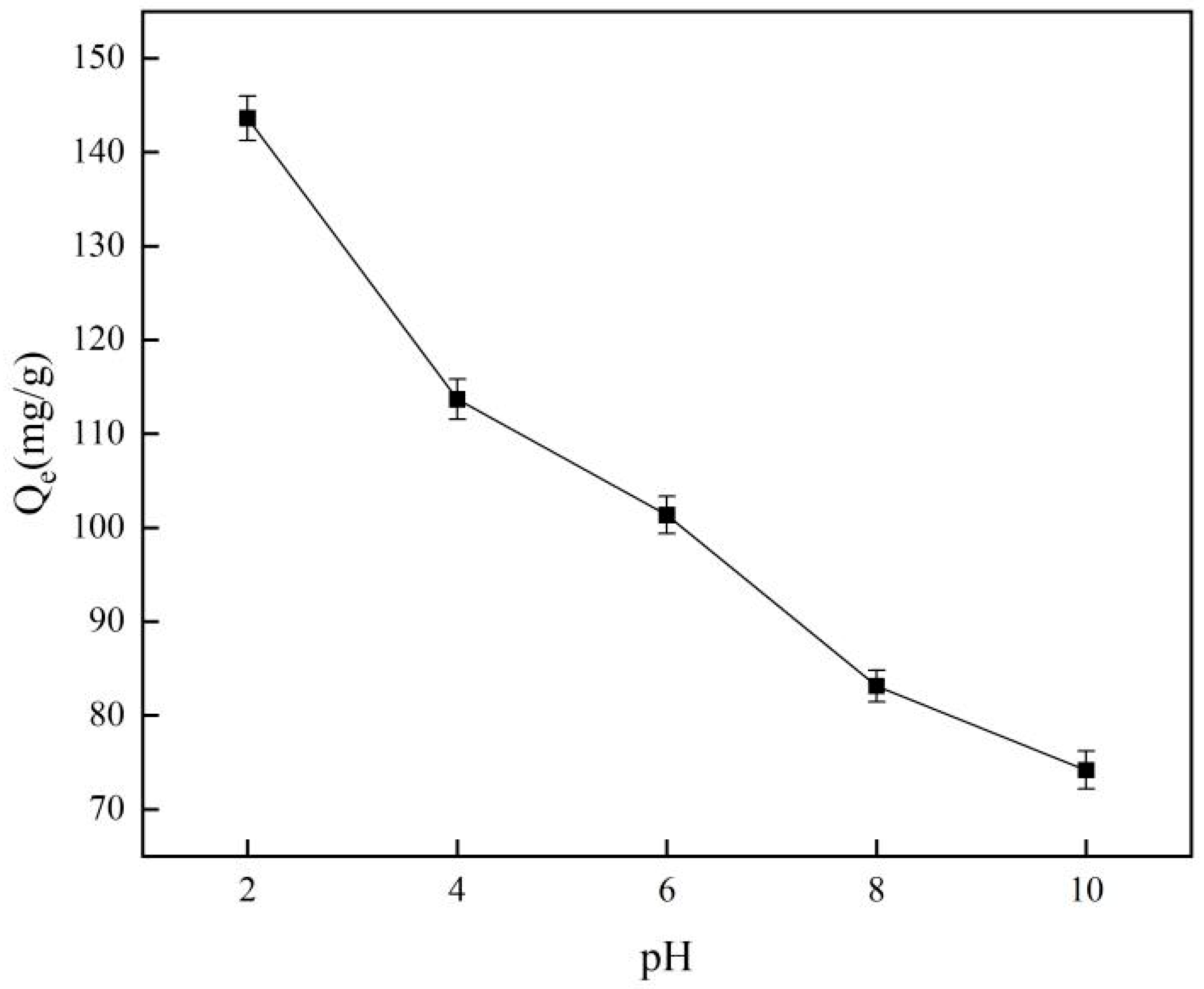
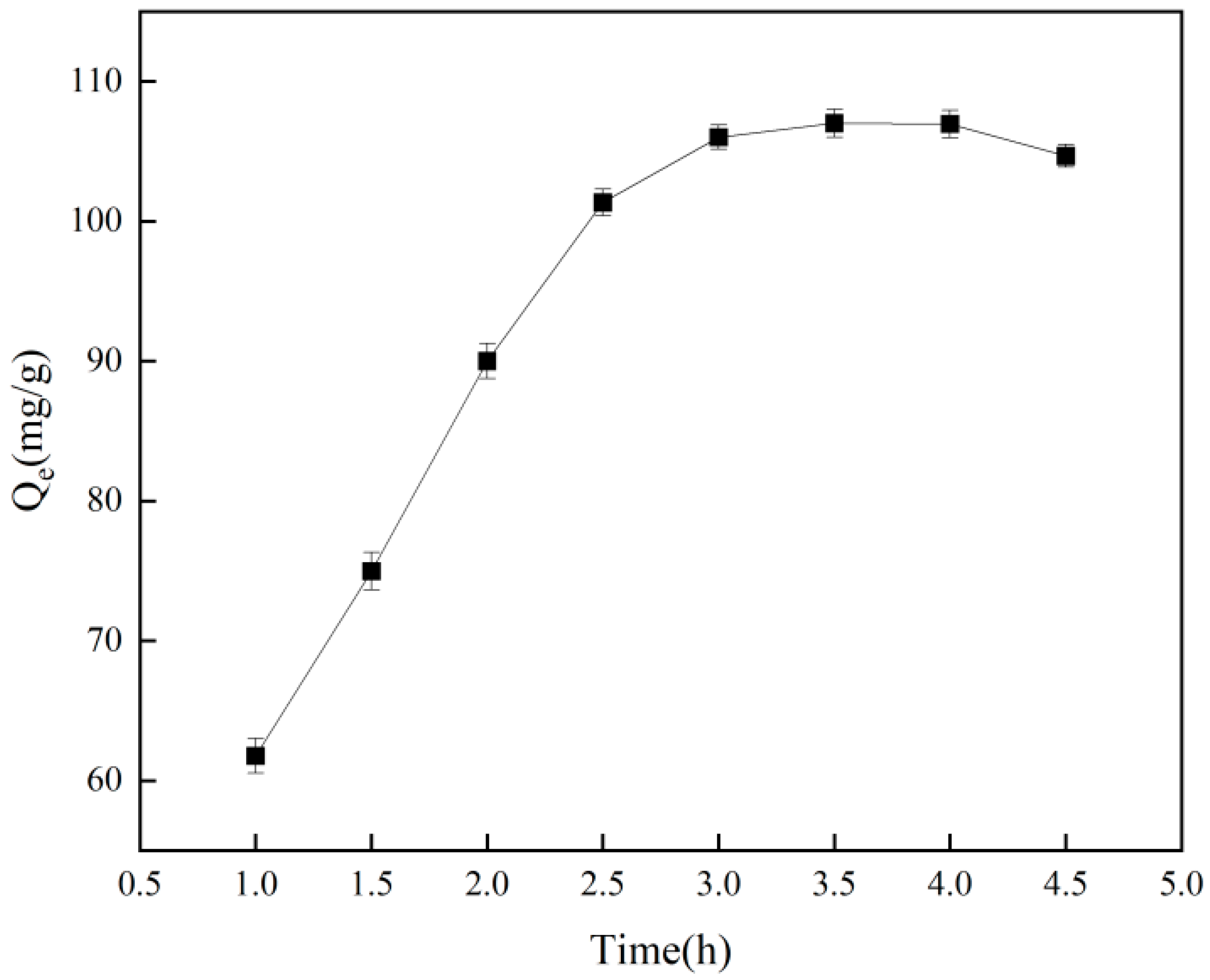
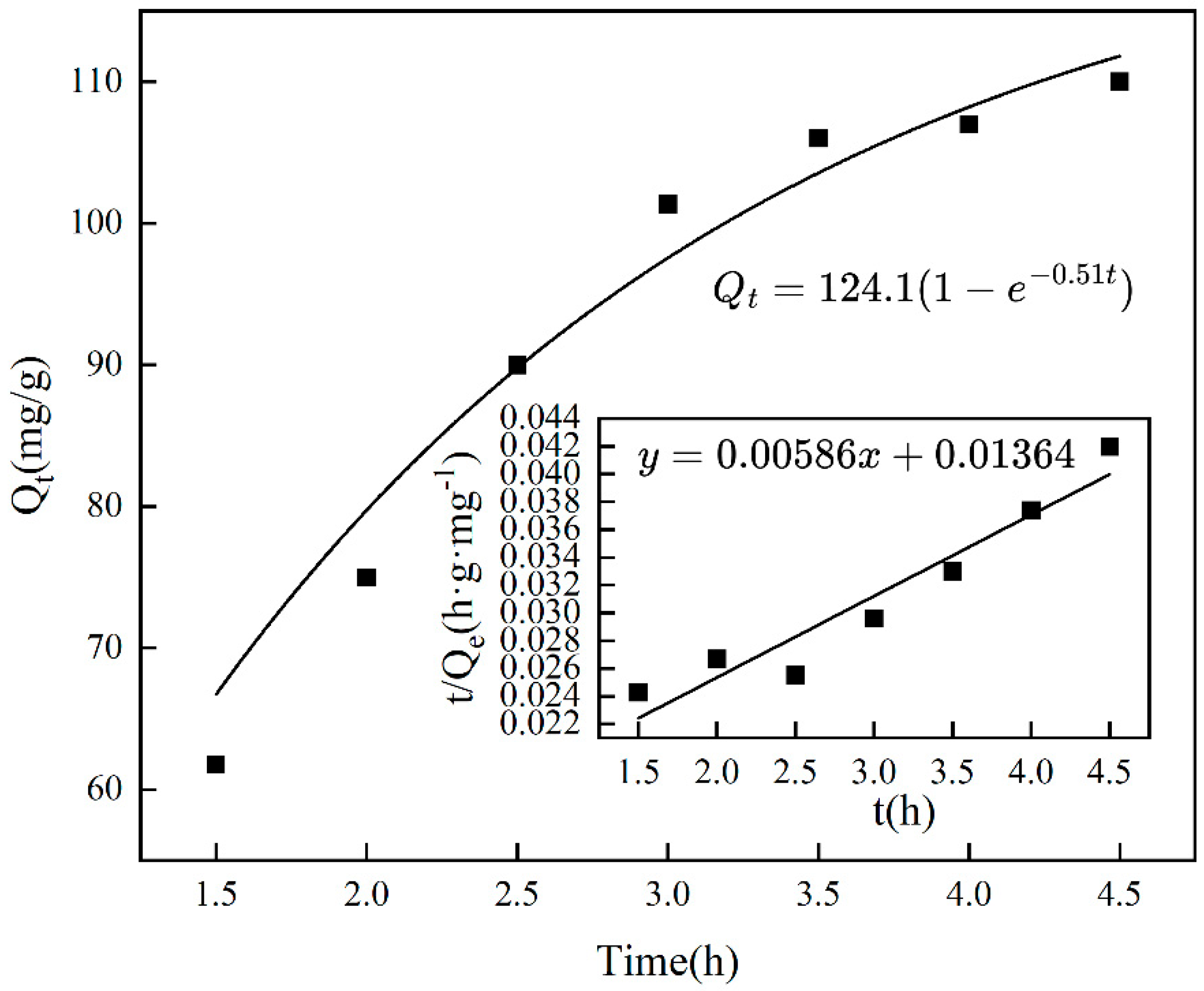

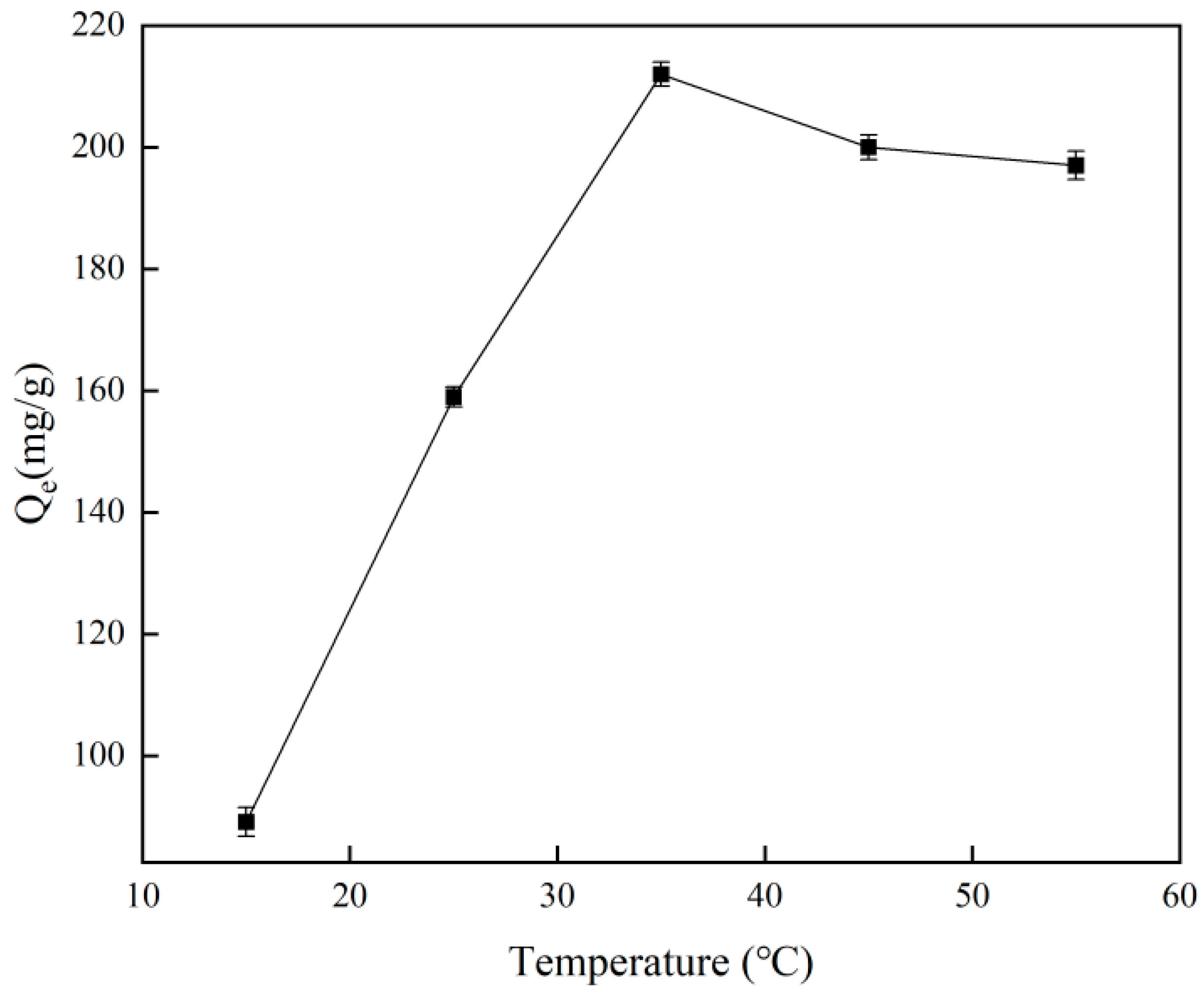
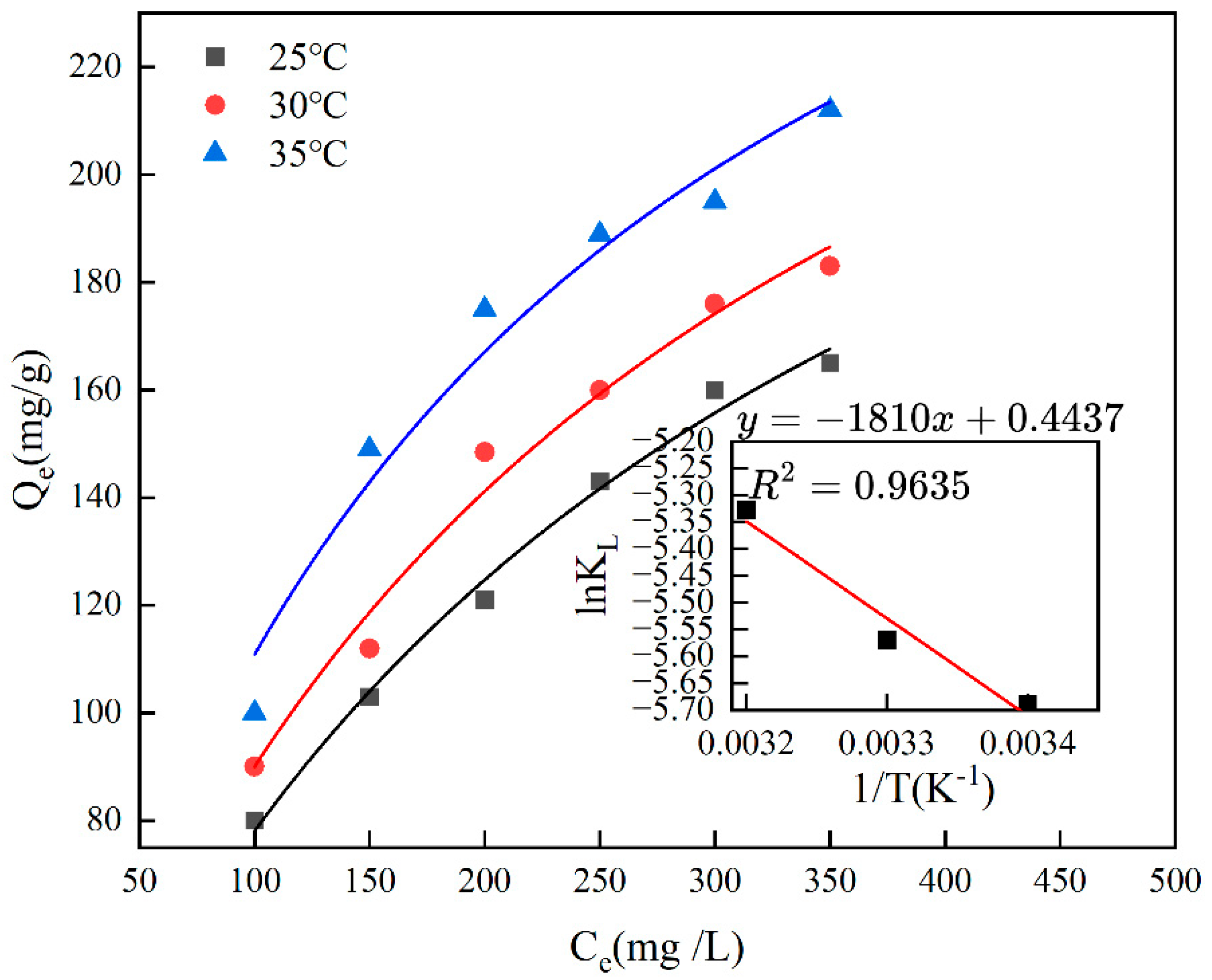
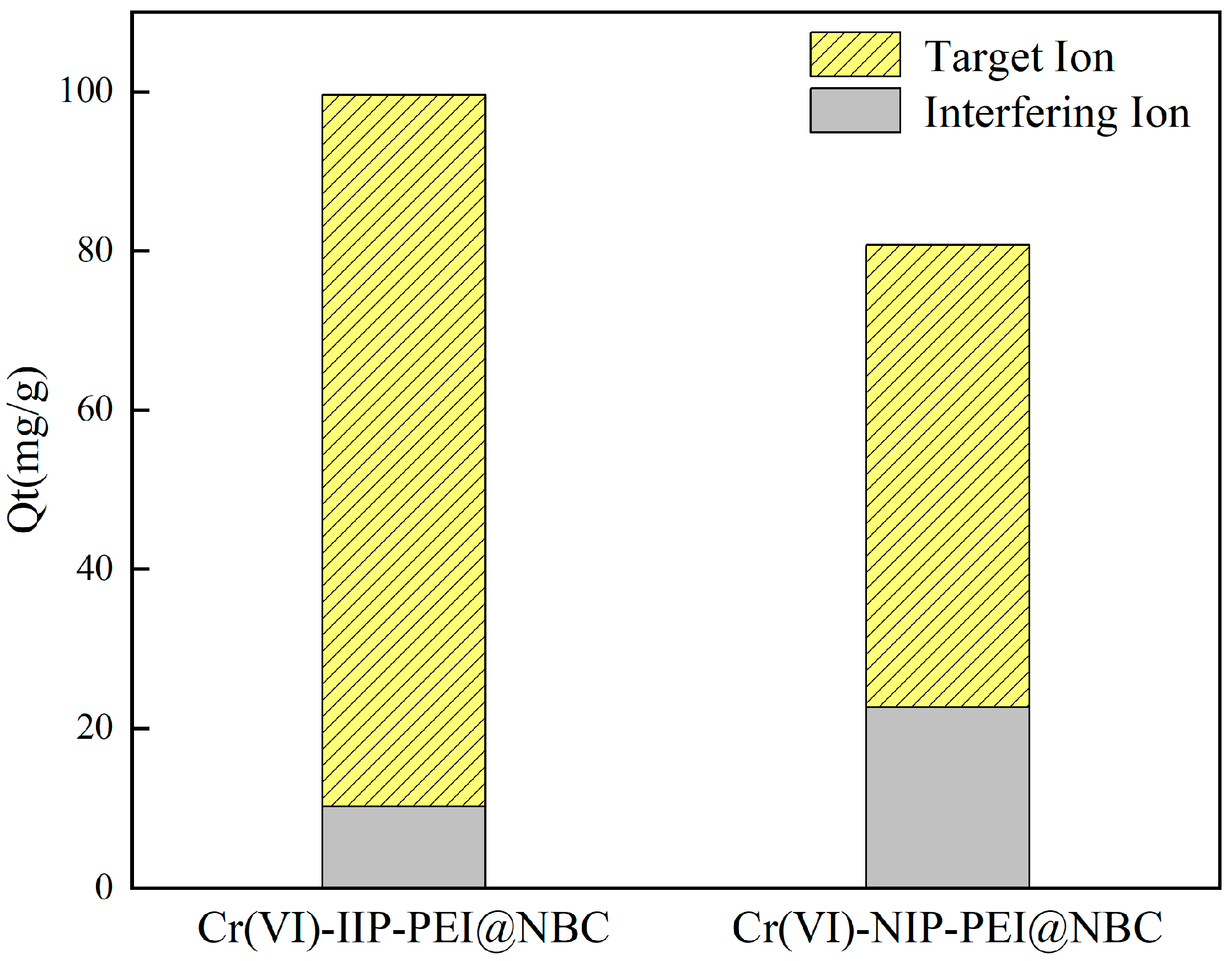
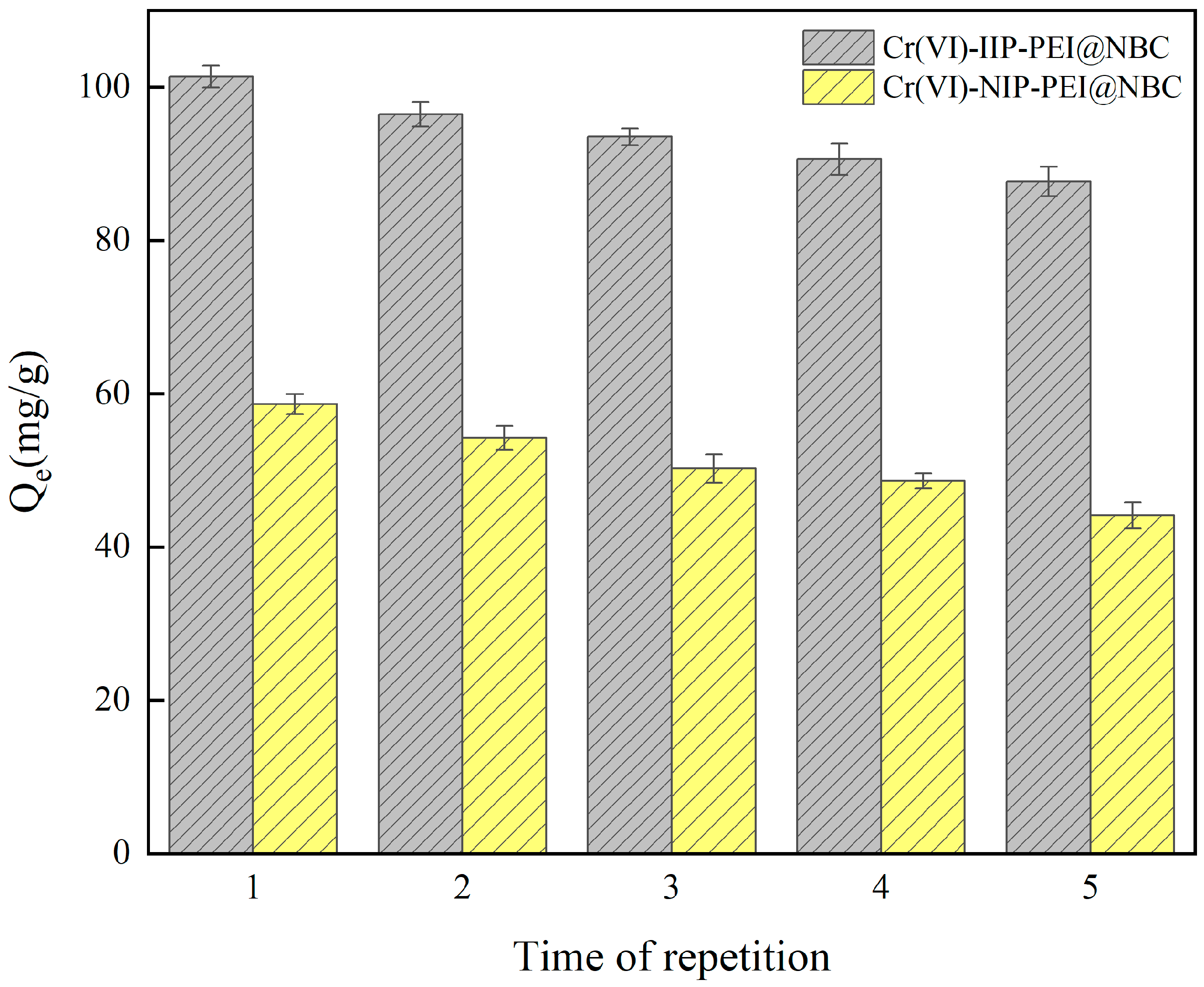
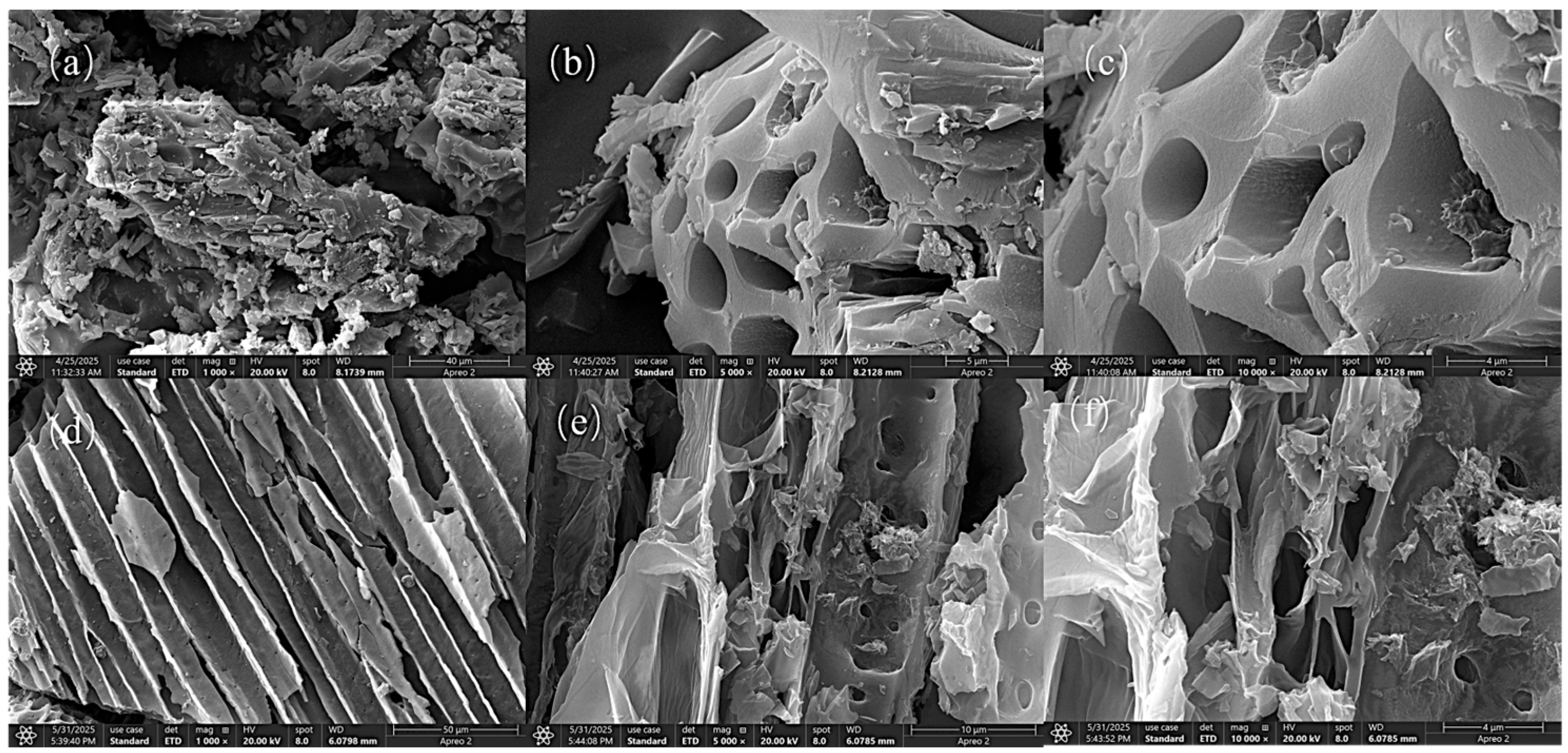
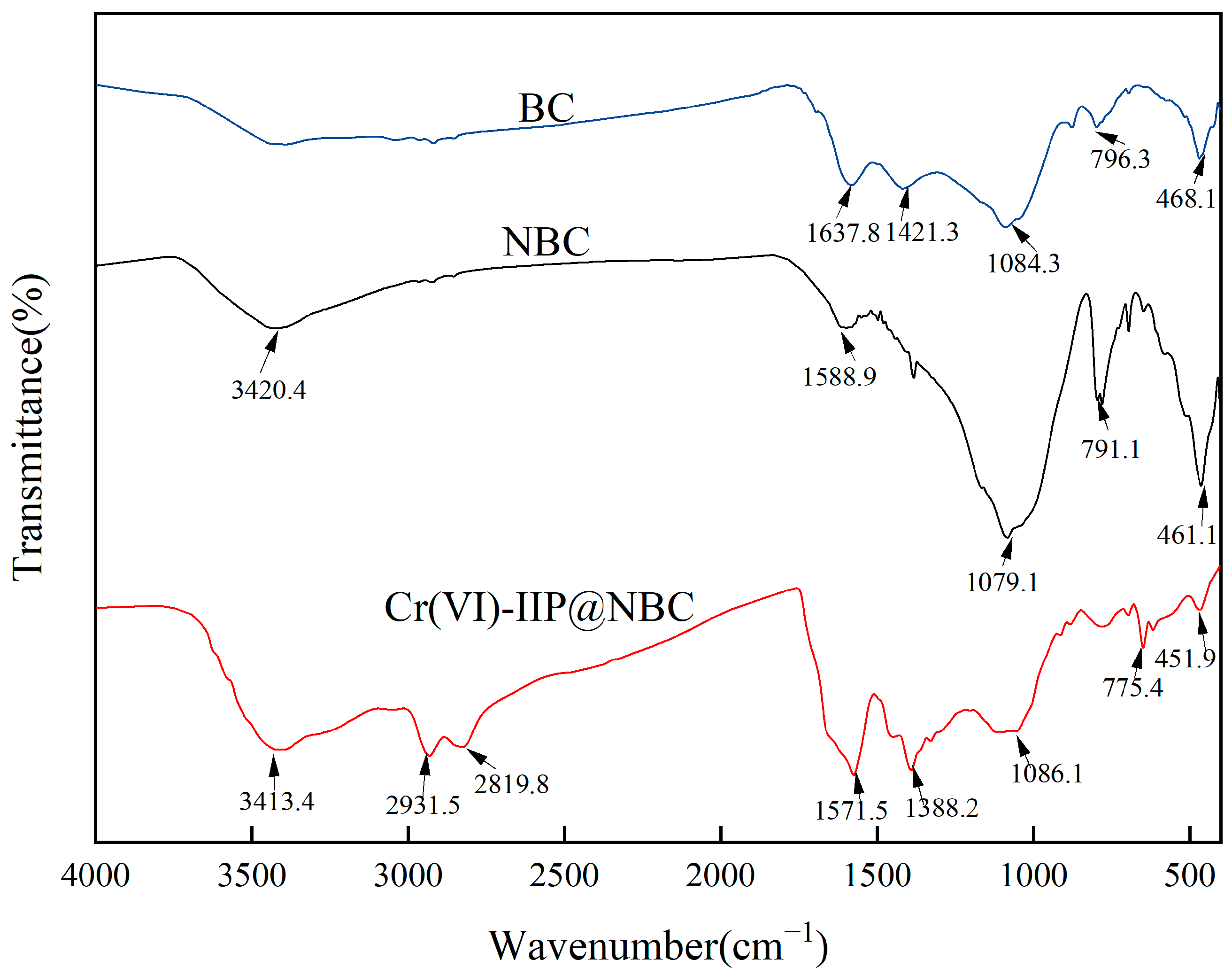
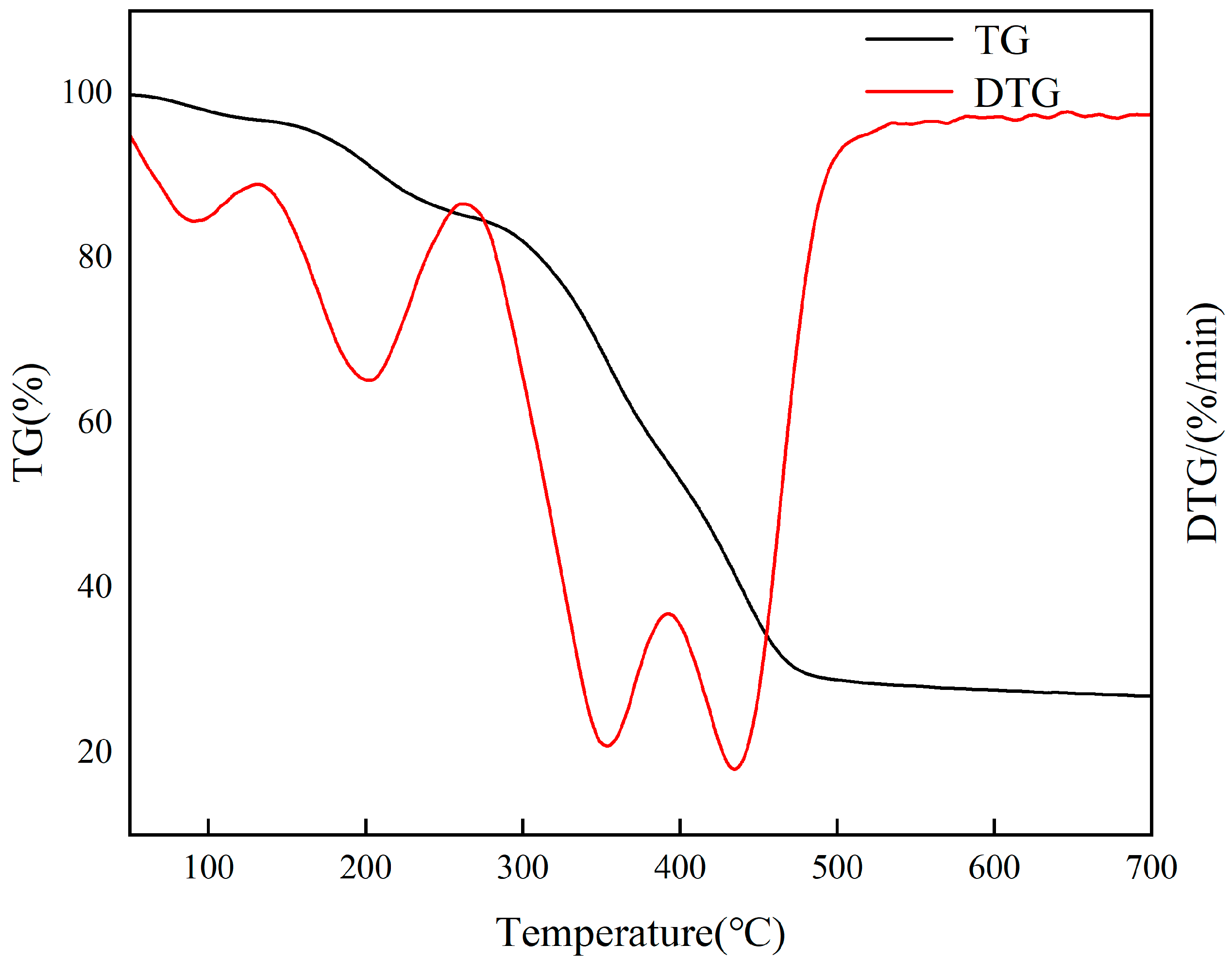
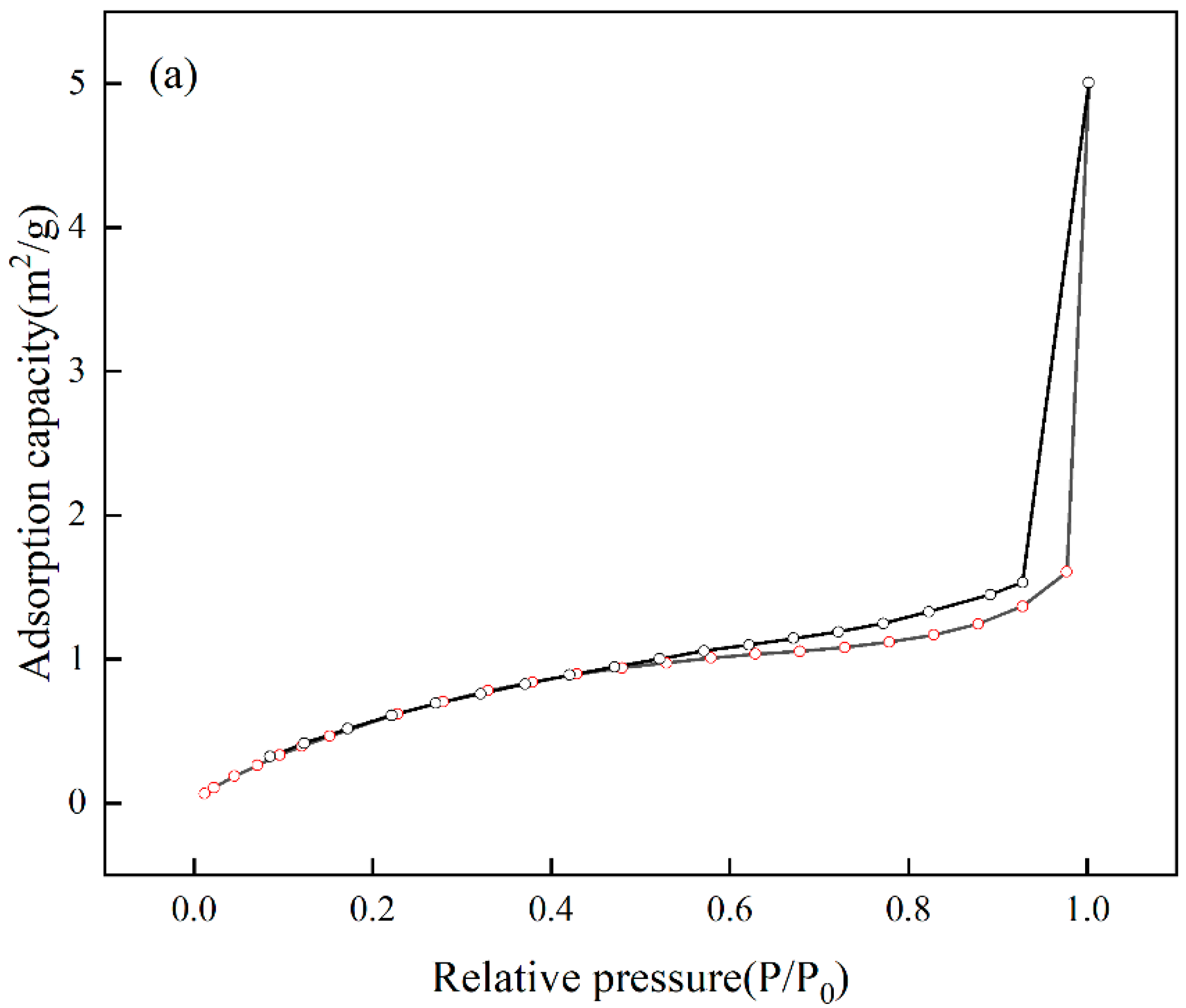
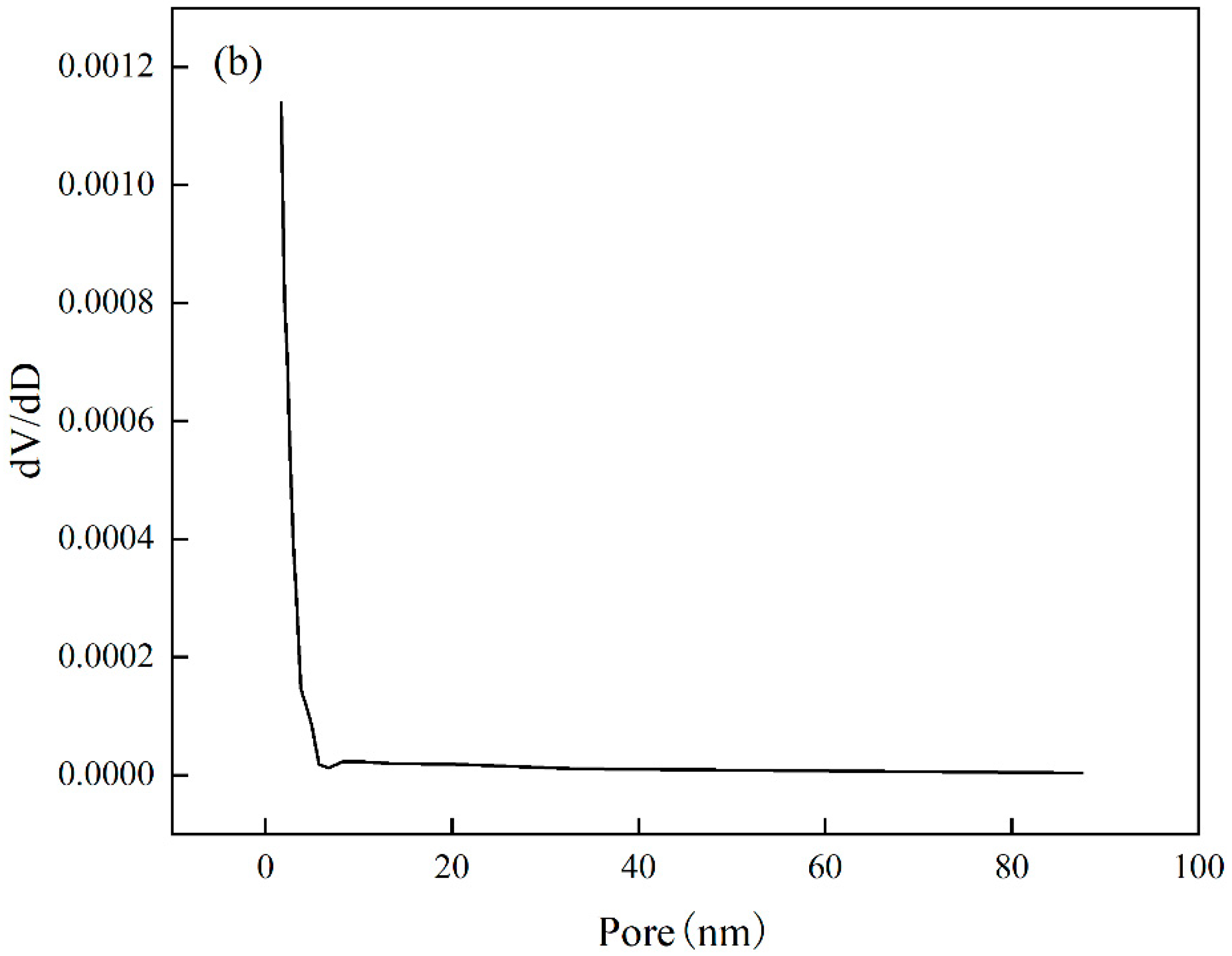
| Kinetics Parameters | Value |
|---|---|
| pseudo-first-order kinetic model: | |
| Qe,cal (mg/g) | 124.1 |
| k1 (min−1) | 0.516 |
| R2 | 0.920 |
| pseudo-second-order kinetic model: | |
| Qe,cal (mg/g) | 170.65 |
| k2 (g/(mg·min)) | 0.0025 |
| R2 | 0.905 |
| Kinetics Parameters | Value |
|---|---|
| Langmuir | |
| KL(L/g) | 0.0064 |
| Qm (mg/g) | 276.47 |
| R2 | 0.9813 |
| Freundlich | |
| KF(L/g) | 14.66 |
| 1/n | 0.44 |
| R2 | 0.9398 |
| Material Name | Absorption Capacity (mg/g) |
|---|---|
| NBC | 6.23 |
| Cr(VI)-NIP-PEI@NBC | 92.45 |
| Cr(VI)-IIP-PEI@NBC | 212.63 |
| T (℃) | ∆G (kJ/mol) | ∆H (kJ/mol) | ∆S (J/mol·K) |
|---|---|---|---|
| 25 | 13.95 | 15.05 | 3.689 |
| 30 | 13.92 | ||
| 35 | 13.91 |
| Absorbent Name | Adsorption Capacity (mg/g) | Reusability * | Reference |
|---|---|---|---|
| Cr(VI)-IIP-PEI@NBC | 212.63 | 84.00% after 5 cycles | This study |
| Cel-PEI | 106.60 | 45.73% after 3 cycles | [36] |
| PEI@AC@Fe3O4 | 98 | 85.00% after 3 cycles | [37] |
| PMGO | 148.98 | 85.60% after 5 cycles | [38] |
| PEIMW@MNHC | 205.37 | 85.6% after 4 cycles | [39] |
| Material Name | Specific Surface Area (m2/g) | Aperture (nm) | Pore Volume (cm3/g) |
|---|---|---|---|
| NBC | 8.7486 | 4.2591 | 0.0387 |
| Cr(VI)-IIP-PEI@NBC | 3.126 | 11.699 | 0.0077 |
Disclaimer/Publisher’s Note: The statements, opinions and data contained in all publications are solely those of the individual author(s) and contributor(s) and not of MDPI and/or the editor(s). MDPI and/or the editor(s) disclaim responsibility for any injury to people or property resulting from any ideas, methods, instructions or products referred to in the content. |
© 2025 by the authors. Licensee MDPI, Basel, Switzerland. This article is an open access article distributed under the terms and conditions of the Creative Commons Attribution (CC BY) license (https://creativecommons.org/licenses/by/4.0/).
Share and Cite
Zong, X.; Duan, T.; Chen, L.; Luo, Z.; Jiang, H.; Geng, W. Synthesis and Characterization of Chromium Ion-Imprinted Biochar for Selective Removal of Cr(VI) from Wastewater. Water 2025, 17, 2910. https://doi.org/10.3390/w17192910
Zong X, Duan T, Chen L, Luo Z, Jiang H, Geng W. Synthesis and Characterization of Chromium Ion-Imprinted Biochar for Selective Removal of Cr(VI) from Wastewater. Water. 2025; 17(19):2910. https://doi.org/10.3390/w17192910
Chicago/Turabian StyleZong, Xinchi, Tianliang Duan, Linyan Chen, Zhengwei Luo, Hui Jiang, and Wenhua Geng. 2025. "Synthesis and Characterization of Chromium Ion-Imprinted Biochar for Selective Removal of Cr(VI) from Wastewater" Water 17, no. 19: 2910. https://doi.org/10.3390/w17192910
APA StyleZong, X., Duan, T., Chen, L., Luo, Z., Jiang, H., & Geng, W. (2025). Synthesis and Characterization of Chromium Ion-Imprinted Biochar for Selective Removal of Cr(VI) from Wastewater. Water, 17(19), 2910. https://doi.org/10.3390/w17192910





